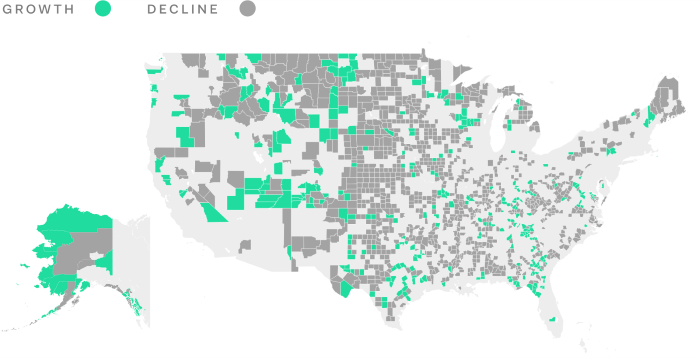The dilemma facing rural funeral homes

The University of Michigan, and their Center for Sustainable Systems Fact Sheet states, “It is estimated that 83% of the U.S. population lives in urban areas, up from 64% in 1950. By 2050, 89% of the U.S. population and 68% of the world population is projected to live in urban areas.”
And Fwd.US states “Population losses in America’s 1,336 rural counties are compounding. Between 2000 and 2010, 346 counties lost 5% or more of their working-age populations. From 2010 to 2020, the losses nearly tripled, with more than 970 rural counties losing 5%. And population declines are expected to continue: between 2020 and 2030, 694 counties will likely see decreases of 5% or more in their working-age populations. . . . . Populations in rural American communities are not only shrinking in size, they are also aging, and rapidly. People living in rural America are, on average, considerably older than the rest of the country.”

Those facts simply state the challenges of operating a funeral home in a small, rural community. As young people grow up, they seem to move out of these communities and the only people left are those that are aging. . .and when they die there is no one to replace them leaving funeral homes in these communities to service less and less deaths each year. . . . In a business where fixed costs dominate the business expenses, such as a funeral home, the business must rely on a stable and reliable mass of business each year to be profitable.
And, that is almost impossible in a community that is losing its resident consumers. In these small rural communities where the number of deaths has dropped a local funeral home’s only option to replace the revenue from a lower number of calls is to raise prices. If a case count has dropped from say 40 cases per year to only 20 death calls per year, how much can prices be increased before even the most supportive of the small town funeral director question the value of the funeral?
I was reminded of that dilemma just last week when a friend of mine sent me the recent funeral bill for his mother at a small country church in North Dakota. . . .The invoice charge? . . . .Just shy of $23,500 for a simple visitation and rural church funeral with burial. There was about $3,000 of cash advances on the invoice, but in my opinion, the charges were more than I would have expected.

Tom Anderson
Funeral Director Daily
And another friend of mine, who buried his 100-year old mother for about $10,000 five years ago, recently told me that the preneed accounts I encouraged him to get for he and his wife totaled over $30,000 (combined) even though their cemetery spaces were already covered. He was amazed at the roughly 50% increase over just a couple of years.
Nobody’s blaming the funeral homes, but one does have to question how long will consumers pay those amounts and will those charges exacerbate the move to out-of-town cremation providers for these consumers?
It’s a tough situation for rural providers who operate in the many rural communities that are losing population. Twenty years ago there were three small-town funeral homes within 20 miles of my funeral home location in what I would term a growing Regional Center community. Of those three one is now closed and the other two are satellites of the Regional Center funeral homes.
From my perspective, I see three types of communities for funeral homes in America all with unique opportunities and challenges – but none have as big a challenge as these small town rural funeral homes:
Urban Communities — A high cost of doing business with high numbers of deaths to compensate for that. The key is to get your market share numbers to be profitable at the price points you choose. These communities continue to grow both organically and through people moving in for employment opportunities. These communities also have enough population to support niche markets such as ethnic services or direct cremation.
While preferences on disposition, celebration, and memorialization may change, there is no doubt that the opportunity to reach a high number of consumers each year gives the opportunity to do very well.
Growing Regional Center Communities — A modest cost of doing business with a high enough population to get the numbers of deaths to be profitable, and extremely profitable, if you get a large market share or operate very efficiently. These communities continue to grow, especially with retired people at the expense of rural communities. I live in a community much like this and see many retired rural community people move to our community because of health care providers and consumer opportunities such as golf courses, theatres, restaurants, and more.
Differing preferences on disposition will be the case, but a “full-service” funeral home can do really well economically if they learn how to offer all of the differing preferences. Niche service or disposition methods may have a difficult time reaching a critical mass to be profitable.
Rural Communities — Small communities that were the backbone of America following World War II. People moved to these communities to open businesses and resident children stayed there to continue operations of farms and businesses. Over the years these communities held there own but some, especially those without geographic luck such as being on the interstate highway system, started losing residents to the urban areas for employment beginning in the 1970’s and to retirement as the Regional Centers begin growing in the 21st Century. While there has been some spurts, that trend of losing population has continued.
Funeral homes in these communities are generally ran by the funeral director and his/her spouse and they at one time did enough funerals to make a good living. Over time, as population has dwindled in these communities funeral homes have less deaths to take care of — coupled with the fact that a growing percentage of their population wants lower-cost and lower-margin cremation services. My wife comes from a small community like this and over the past 40 years the community has lost over 50% of its population. Her graduating class was about 80 students. . . today the community will be lucky to graduate 30 in any given year.
These are the funeral homes who will face the dilemma of how they survive. . . .The double-edged sword is 1) Too few services to be profitable and 2) The 24/7/365 lifestyle that no one seems to want anymore.
Where there is a Will, is there a Way? — These small rural communities have almost all lost their full-service grocery stores causing resident consumers to drive over 25 miles to buy groceries. The company, Dollar General, noticed this – they now operate over 19,000 locations – and has capitalized becoming the “de facto” Wal Mart stores of these communities. Is there a way for “Death Care” to do the same?
More news from the world of Death Care:
- Government to pay out Youpla/ACBF customers after failed insurer made millions off Centrelink payments. ABC News (Australia)
- Body donation programs need cadavers. Cosmos
- An Anchorage woman is working to offer water cremation and other natural death care options in Alaska. NPR – Alask Public Media (AK)
- Des Moines might sell part of a cemetery. Axios Des Moines
- Death is inevitable. A new kind of cremation is trying to make it sustainable. Popular Mechanics
Enter your e-mail below to join the 3,466 others who receive Funeral Director Daily articles daily:
“A servant’s attitude guided by Christ leads to a significant life”





















Very well written and so true!
Excellent column sir.